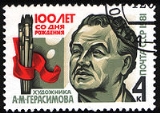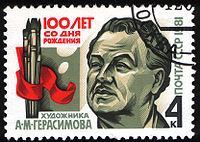
Alexander Gerasimov
Encyclopedia

Socialist realism
Socialist realism is a style of realistic art which was developed in the Soviet Union and became a dominant style in other communist countries. Socialist realism is a teleologically-oriented style having its purpose the furtherance of the goals of socialism and communism...
in the visual arts, and painted Joseph Stalin
Joseph Stalin
Joseph Vissarionovich Stalin was the Premier of the Soviet Union from 6 May 1941 to 5 March 1953. He was among the Bolshevik revolutionaries who brought about the October Revolution and had held the position of first General Secretary of the Communist Party of the Soviet Union's Central Committee...
and other Soviet leaders.
Gerasimov was born on August 12, 1881 in Kozlov (now Michurinsk
Michurinsk
Michurinsk , before 1932—Kozlov , is the second most populous town in Tambov Oblast, Russia. Population: It was founded in 1635 at the northern end of the emerging Belgorod Line. A 25-km earthen wall was built eastward across the open steppe effectively blocking the Nogai Trail, a Tatar raiding...
) in Tambov
Tambov
Tambov is a city and the administrative center of Tambov Oblast, Russia, located at the confluence of the Tsna and Studenets Rivers southeast of Moscow...
Governorate
Guberniya
A guberniya was a major administrative subdivision of the Russian Empire usually translated as government, governorate, or province. Such administrative division was preserved for sometime upon the collapse of the empire in 1917. A guberniya was ruled by a governor , a word borrowed from Latin ,...
. He studied at the Moscow School of Painting, Sculpture and Architecture
Moscow School of Painting, Sculpture and Architecture
The Moscow School of Painting, Sculpture and Architecture was one of the largest educational institutions in Russia. The school was formed by the 1865 merger of a private art college, established in Moscow in 1832, and the Palace School of Architecture, established in 1749 by Dmitry Ukhtomsky. By...
from 1903 to 1915. There he championed traditional realistic representational
Representation (arts)
Representation is the use of signs that stand in for and take the place of something else. It is through representation that people organize the world and reality through the act of naming its elements...
art against the avant-garde
Avant-garde
Avant-garde means "advance guard" or "vanguard". The adjective form is used in English to refer to people or works that are experimental or innovative, particularly with respect to art, culture, and politics....
.
During World War I
World War I
World War I , which was predominantly called the World War or the Great War from its occurrence until 1939, and the First World War or World War I thereafter, was a major war centred in Europe that began on 28 July 1914 and lasted until 11 November 1918...
and the Russian Civil War
Russian Civil War
The Russian Civil War was a multi-party war that occurred within the former Russian Empire after the Russian provisional government collapsed to the Soviets, under the domination of the Bolshevik party. Soviet forces first assumed power in Petrograd The Russian Civil War (1917–1923) was a...
he served in the army. Subsequently he returned to his hometown to become a stage designer, helping to present plays glorifying the Revolution and the Soviet government.
In 1925, Gerasimov returned to Moscow and set up a studio, combining techniques of academic realism with an Impressionistic light touch. He favored a style known as heroic realism, which featured images of Revolutionary leaders such as Vladimir Lenin
Vladimir Lenin
Vladimir Ilyich Lenin was a Russian Marxist revolutionary and communist politician who led the October Revolution of 1917. As leader of the Bolsheviks, he headed the Soviet state during its initial years , as it fought to establish control of Russia in the Russian Civil War and worked to create a...
as larger-than-life heroes. However, as Stalin tightened his grip on the country, Gerasimov's work descended into pompous official portraits, such as "Stalin and Voroshilov in the Kremlin," for which he won a Stalin Prize in 1941. He produced a large number of heroic portraits of Kliment Voroshilov
Kliment Voroshilov
Kliment Yefremovich Voroshilov , popularly known as Klim Voroshilov was a Soviet military officer, politician, and statesman...
, to the point that Nikita Khrushchev
Nikita Khrushchev
Nikita Sergeyevich Khrushchev led the Soviet Union during part of the Cold War. He served as First Secretary of the Communist Party of the Soviet Union from 1953 to 1964, and as Chairman of the Council of Ministers, or Premier, from 1958 to 1964...
would later accuse Voroshilov of having spent most of his time in Gerasimov's studio, to the detriment of his responsibilities as People's Commissar of Defense.
His heavy-handed leadership of the Union of Artists of the USSR and the Soviet Academy of Arts were notorious, and he was at the forefront of the attacks against cosmopolitanism
Cosmopolitanism
Cosmopolitanism is the ideology that all human ethnic groups belong to a single community based on a shared morality. This is contrasted with communitarian and particularistic theories, especially the ideas of patriotism and nationalism...
and formalism
Russian formalism
Russian formalism was an influential school of literary criticism in Russia from the 1910s to the 1930s. It includes the work of a number of highly influential Russian and Soviet scholars such as Viktor Shklovsky, Yuri Tynianov, Vladimir Propp, Boris Eichenbaum, Roman Jakobson, Grigory Vinokur who...
during the Zhdanovshchina.
Although his excessively fawning portraits of Soviet leaders and his political activities against artists who would not toe his line have gained him a reputation as a political hack
Political hack
A political hack is a negative term ascribed to a person who is part of the political party apparatus, but whose intentions are more aligned with victory than personal conviction...
, Gerasimov did not entirely lose touch with his genuine artistic abilities. Even at the end of his career, he continued to follow a moody, almost Impressionistic treatment of landscapes, curiously at odds with the stridency of his official portraiture.

